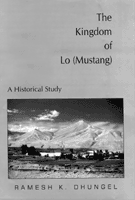The kingdom of Mustang, bordering Tibet to the north and Thak Khola to the south, has long been an object of fascination to foreign scholars of the Himalaya. Although three generations of Western and Japanese travellers and professors have cut their teeth on the cultures, languages, geology and archaeology of Mustang, few Nepalis have conducted substantial research projects in the region.
Dr Ramesh Kumar Dhungel, a cultural historian at the Centre for Nepal and Asian Studies (CNAS) of Tribhuban University, is a notable exception. He is one of a handful of Nepali academics with professional interest in the culture and history of the high Himalaya. As Dhungel pointed out at the launch of The Kingdom of Lo (Mustang): A Historical Study, working in Mustang required him to keep an open mind regarding local observances. It is a tribute to Dhungel's obvious good cheer and unjudgemental approach to scholarship that the Crown Prince of Mustang, Gyalchung Jigme SP Bista, privately published the present monograph to raise money for the restoration of Mustang's ancient gompas.
Dhungel's early research in Mustang was conducted between 1982-83, so this monograph can truly be said to have had a long gestation period. Largely based on genealogical documents, the book is a historical study of the kingdom from the 7th century to about 1950. It charts both the emergence of a polity in 1440 (which came to be called Lo/Mustang) and how "key geographical, cultural and political realities had earlier shaped its regional identity". On account of both its geographical location on the trans-Himalayan trade route and the vibrancy of the local Buddhist culture, Mustang retained considerable political autonomy until its incorporation into Nepal in 1789, to which it paid tribute as a dependent until 1961, when this status was rescinded by the Dependent Principalities Act. The title of raja, together with a selection of traditional rights, allowances and honorary positions are still retained to this day. Including the present king of Mustang, the kingdom has been ruled continuously by 21 generations of rajas heralding from the same dynasty.
The book is divided into five chapters with a physical and cultural overview to the region, the background to the emergence of Lo/Mustang, the events until the late 18th century when Mustang was subjugated by Gorkha, including local efforts to maintain the territorial integrity of the region and discussions up to the mid-20th century.
The author excels at the translation, decoding and analysis of genealogical, chronological and bibliographical documents. Many of these texts, originating in Tibetan, Nepali or older variations, make for fascinating reading. Other disciplines, however, are a little beyond Dhungel's remit and he is misinformed when he writes: "no detailed study on the languages and cultures of the entire Lo/Mustang region (both upper and lower) has been attempted". There have been scores of detailed linguistic and ethnographic studies of the area since he conducted his research in the 1980s.
Dhungel pulls no punches, and is as critical of other scholars as he is supportive of their achievements. In his chronology of Mustang-ologists and the associated 30-page bibliography, however, there are some glaring omissions, most notably the many published works by Charles Ramble and Dieter Schuh. Likewise, while foreign scholars are lambasted for not conducting grassroots fieldwork, there is little recognition by Dhungel of the difficulty of obtaining permits for such empirical research. Given that Nepalis can travel to Mustang freely, Dhungel could have perhaps recommended that more Tribhuban University scholars focus their research interests on this important area of Nepal.
The appendices include a fascinating discussion on the etymology of Mustang place names, 26 historical Nepali documents and 24 Tibetan ones, both reproduced in the original scripts. Readers casually interested in the history of Mustang should be forewarned: this is a serious, scholarly historical work, requiring some previous exposure to Tibetan historiography and an interest in genealogy and dates. The facts come alive through the 30 pages of well-reproduced colour plates, many of them photographs by the professional photographer Macduff Everton, while others depict a young Dhungel in various locations throughout Mustang.
The author cites the writer Victor Kiernan who has suggested that colonial scholars, in particular the British, were "bound to see the local history from a standpoint of their own". Such orientalist perspectives are sadly still quite widespread, particularly among socially-dominant and high caste Nepali scholars whose condescending research writings on Nepal's minority ethnic and linguistic communities leave much to be desired. Dr Dhungel's book, on the other hand, is a welcome antidote to this depressing trend, since his respect for and appreciation of the people of Mustang and their history pervades every page of his impressive monograph.
 The Kingdom of Lo (Mustang): A Historical Study Ramesh K Dhungel
The Kingdom of Lo (Mustang): A Historical Study Ramesh K Dhungel
Jigme SP Bista for Tashi Gephel Foundation, Nepal, 2002
Price: Rs 2,000 (Hardback)
Rs 1,600 (Paperback)
Mark Turin is Director of the Digital Himalaya Project based jointly at the University of Cambridge and at Cornell University.


